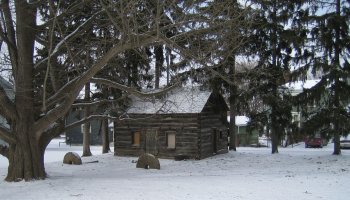- By Dan Veaner
- News
 Print
Print 
Claes Nyberg
Indeed the Hyde Log Cabin in Grand Isle, VT claims to be the oldest log cabin the the United States. It was built in 1783, a good 34 years after the Lansing cabin is thought to have been built. The Adsit Log Cabin was built in Willsboro Point near Lake Champlain in 1778. While older than the Hyde cabin it is still not as old as the North cabin may be. "That really make you think twice about what you're going to do with it, that's for sure," says Lansing Town Supervisor Scott Pinney. "When you hear that it's one of the oldest ones that is definitely a factor."
But Pinney, and the entire Town Board is concerned about costs. The reason the cabin was disassembled to bring it from Auburn to Lansing was that using highway department labor during a slow period was much less expensive than hiring a company to move the cabin intact. Now the Town is faced with the cost of reconstructing it, which will have to include some kind of slab or foundation and a new roof (the roof was not part of the original cabin).
| How Historical Is The Cabin? Two years ago when the North Cabin was offered to Lansing by the Cayuga Museum Bud Shattuck did some research, and was told some of its history by museum staff. Chris Muka spent over 20 hours researching the cabin and the North family. But he was not able to pinpoint the cabin's exact original location, which is thought to be near the intersection of Searles and Conlon Roads. We know the cabin was moved to around 578 Conlon Road in 1844. Muka noted that hemlock trees are plentiful in a ravine north of that location, so he surmises that the cabin, built of hemlock logs, must have been built nearby. Shattuck says that getting official historic designation may be difficult according to what he was told by museum staff and a building mover that was being considered for bringing the cabin to Lansing in one piece. "The problem is that they both said that because of changes to it, it would not pass muster for a historically accurate building," Shattuck says. "It had changed enough that that wouldn't happen. I don't know how those designations happen." But Shattuck notes that it could be possible to learn more that would help in that task. "This cabin has the original size and shell, and most of those logs -- you could probably carbon date them to find out if it's 250 years old. The doorway may have changed, and the loft may not be historically perfect, but I would think that looking into historical designation would help." Past Log Cabin Stories
| ||
"It's just laying on the ground," Pinney says. "At this point it's deteriorated so the cost to erect it could be very substantial. I'm very concerned about spending taxpayers' money to put that up. If we have somebody that is willing to pay all those costs and put it on their land and keep it open to the public, it would be a savings to the taxpayers."
Shattuck isn't talking about taxpayer money either. But he says that the cabin is stacked on a concrete slab, protected by a tarpaulin and he doesn't think one more winter will cause the cabin to deteriorate more. In May Pinney set a two month deadline to either find a location or give the cabin to Common Field. But Shattuck is hoping that if he can form a committee and get a plan in place to seek funding, a location, and a construction plan for next summer that he will be given more time.
"My hope is to get together a group of people in the next couple of weeks," he says. "Approach the board members as a whole (with a plan). I would guess that if you asked them right now they would all say no, but hopefully thinking about what it means to other people and what it means to the community, as opposed to what it means to them individually they would agree that if we can get someone to run a committee and start to put things together with the idea of construction next year. If someone wants we could bring in a logger or a forestation person to talk about what the deterioration would be we could do that."
Enter Chris Muka and his Common Field, a not for profit 501-C3 corporation dedicated to historical and natural conservation, preservation, and recreation. Over a year ago Muka offered a small patch of land on Salmon Creek Road, that happens to be in military lot 71, a plot of land originally used to pay off Revolutionary War soldiers that is thought to include the cabin's original location. Placing it within the same military lot could make it eligible for more grant money.
But critics of the Common Field proposal say that the Salmon Creek Road site is too small, and not located where people could easily find the cabin. They say it should be where people naturally go. Last year highway department officials checked the site, and determined that it is too small to hold the cabin and parking for visitors. Since then Muka has applied for a zoning variance to allow a cabin to be placed there. He has said he will erect a different cabin if the Town doesn't give him the North cabin.
New objections to giving the cabin to Common Field have arisen since Nyberg pointed out that it is one of the oldest, if not the oldest known log cabin in the country. Nyberg suggested it be located in Myers Park or on Salt Point. The Town Hall or ball field areas and Myers Road have also been mentioned as good locations. "It should be in a place with high traffic where tourists and individuals from out of town can see it," said resident Dave Heck. "The ideal place would be Myers Park or the gravel pit coming down Myers Park to the four-way stop."
Shattuck says that others in town have offered land, but worries about complications arising from putting town property on someone else's property, adding that the ideal location would be on property the town owns itself. He says his preference would be a piece of land that the town owns at the foot of the hill before you cross the railroad tracks, to the left where the gravel bed was on the way down to Myers Park. But Pinney says that piece of land is not under consideration.

The North cabin at the Cayuga Museum before being
disassembled and transported to Lansing last year
disassembled and transported to Lansing last year
At first glance Park Superintendent Steve Colt likes the idea of putting it near the paved parking lot at the entrance to Salt Point. He says that the rustic feel of the cabin fits the atmosphere there, and that a spot near the parking lot is perfect for visiting school groups and others. "I think that idea has got a lot of merit," he says. "You could really make a nice destination out of it. It would give you a reason to go out there, and then maybe you'd stumble onto the rest of Salt Point, which is also a great place."
Shattuck agrees that would be a good location even though the Town doesn't technically own it. Lansing holds a long term lease to manage Salt Point from the New York Department of Environmental Conservation (DEC). "I don't see why that wouldn't work, because it's a portable building," he says. "I mean we put a parking lot in, we put a road in. I'm open to any suggestion. We as a board haven't sat down and talked about this."
"This is a treasure," Nyberg told the Town board. "States like Michigan and Illinois have lots of log cabins. They have log cabin festivals every year. But they don't have a cabin from 1749. I think you have to be very careful before you give it away. When you end your careers on the Town Board, if you do something right with this cabin that will be your finest memory and most proud achievement."
----
v4i29




